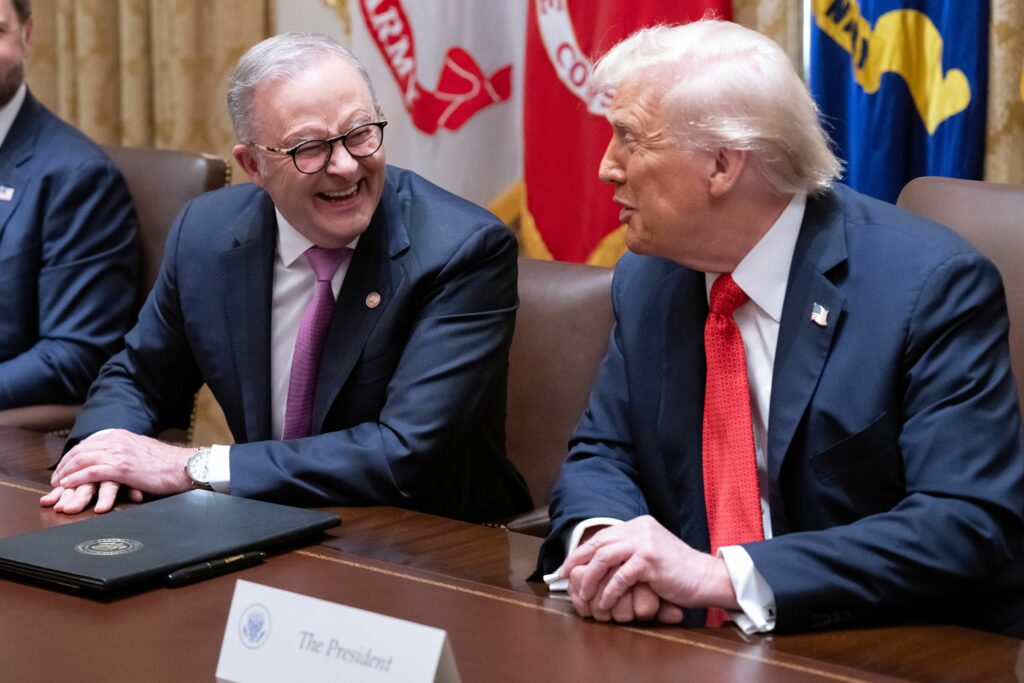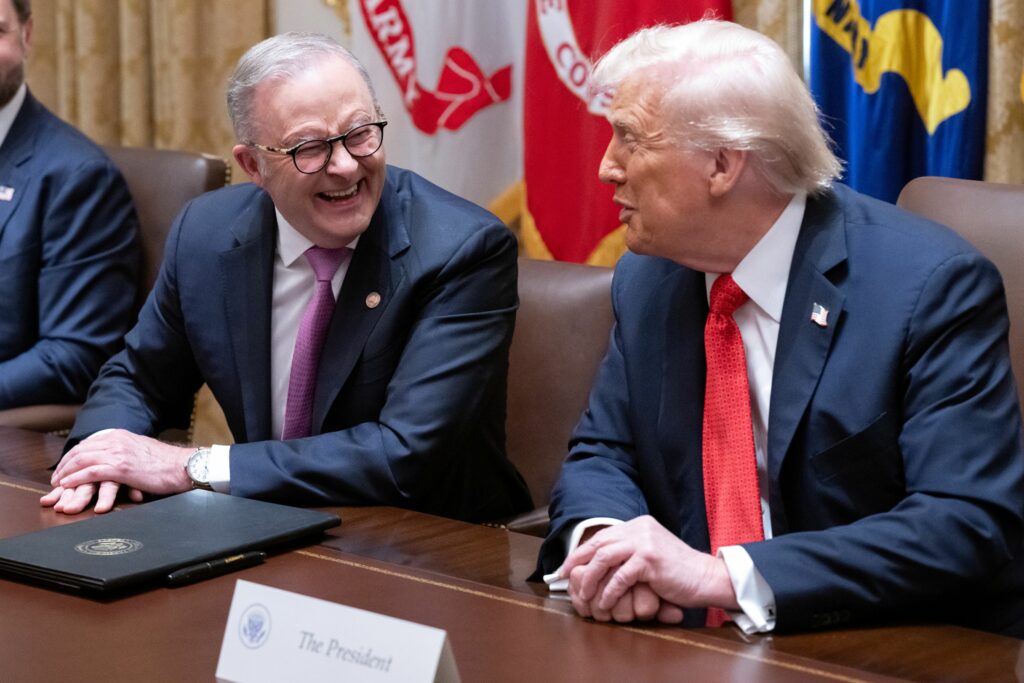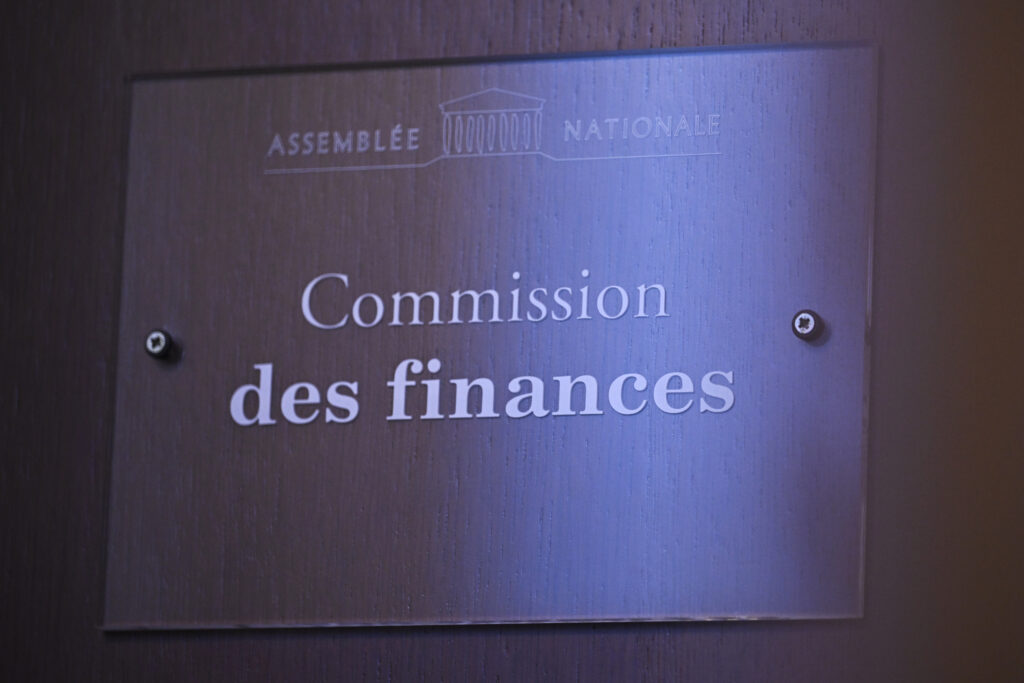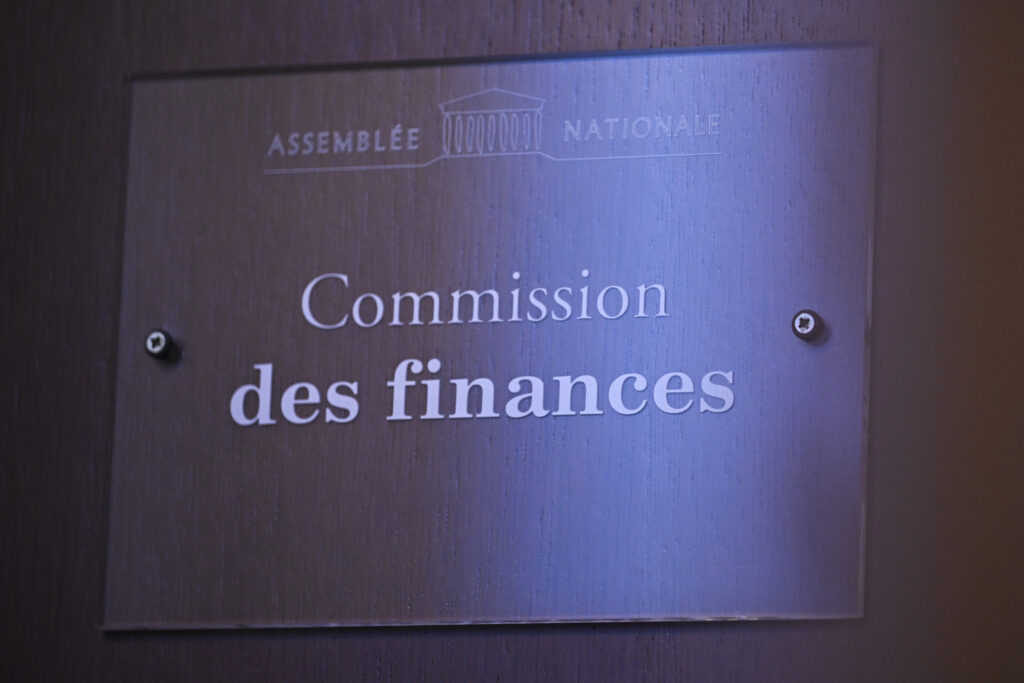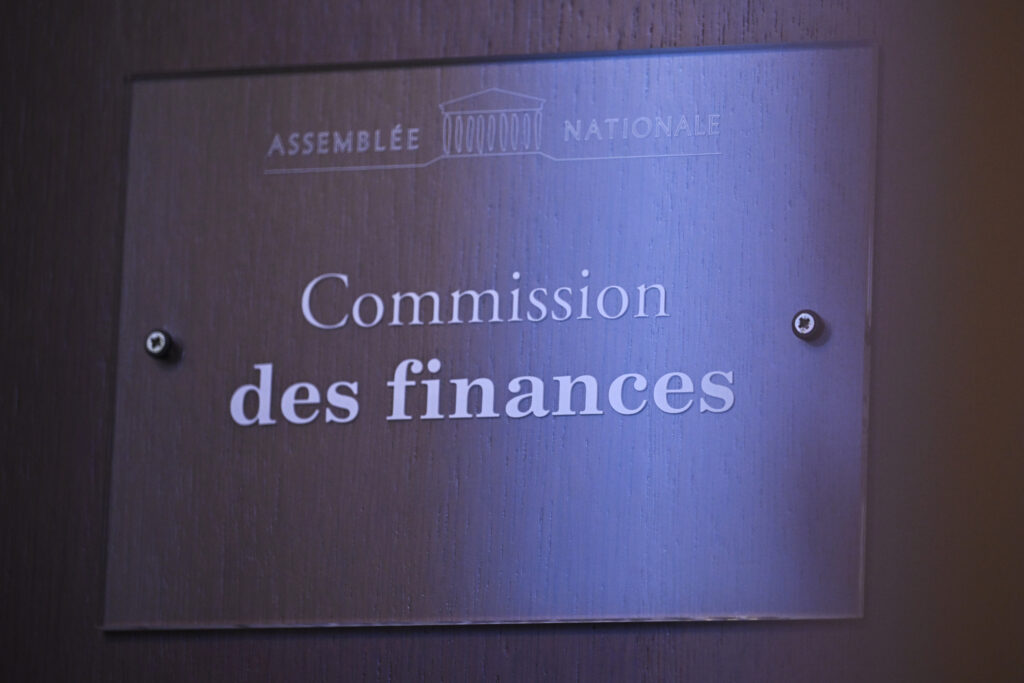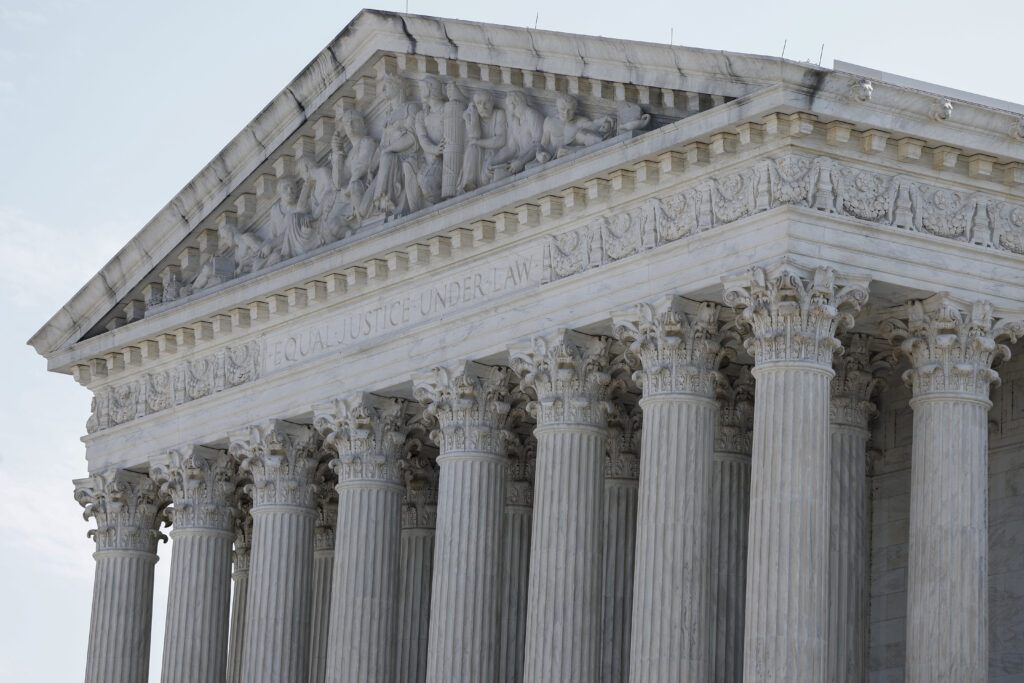Trump says Australia will get submarines as PM visits
US President Donald Trump said Australia would get coveted nuclear-powered attack submarines and signed a deal on rare earth minerals with Prime Minister Anthony Albanese at the White House on Monday.The promise to Australia, which promotes itself as a key US ally against China, came after the Trump administration said earlier this year it was reviewing a deal for the subs signed under previous president Joe Biden.”The submarines that we’re starting to build for Australia are really moving along,” Trump told reporters as he sat alongside Albanese in the cabinet room of the White House.”We’ve worked on this long and hard, and we’re starting that process right now. And it’s really moving along very rapidly, very well.”The two leaders also signed a deal on critical minerals and rare earths, which are vital for the technology that runs the global economy. Albanese has touted Australia’s abundant critical minerals as a way to loosen China’s grip over global supplies.The Australian premier meanwhile managed to ride out an awkward confrontation between Trump and Australia’s ambassador to Washington — former prime minister Kevin Rudd.Rudd deleted a series of critical social media posts about Trump following the Republican’s election victory last year.”I don’t like you either. I don’t. And I probably never will,” Trump said to Rudd when a reporter pointed out that the ex-PM was in the room and asked the US president whether he minded the comments.Australians have a mostly unfavorable view of the Trump administration, polling shows, though the country relies on the United States to balance China’s expanding military clout in the Pacific region.- Rare earths -Australia’s government had been hoping for Trump’s blessing of the 2021 agreement for at least three of the silent, Virginia-class submarines within 15 years.The AUKUS submarine deal between Australia, the United Kingdom and the United States could cost Australia up to US$235 billion over the next 30 years, according to Canberra.But the Trump administration said in June it had put AUKUS under review to ensure it aligned with his “America First agenda.”Some domestic critics had said the United States did not produce enough Virginia-class submarines to supply Australia as well as its own navy.The nuclear-powered vessels lie at the heart of Australia’s strategy of improving its long-range strike capabilities in the Pacific.Australia had a major bust-up with France after it tore canceled a multibillion-dollar deal to buy a fleet of diesel-powered submarines from Paris and go with the AUKUS program instead.In the run-up to the White House talks, Australia also sold itself to Washington as a future source of critical minerals including rare earths — of which China is by far the world’s largest supplier.Australia sits on deposits of lithium, cobalt and manganese as well as rare earth metals used in technologies from semiconductors to defense hardware, electric cars and wind turbines.Albanese announced plans in April for a strategic reserve of critical minerals to provide to “key partners” such as the United States.The reserve is designed to help relax China’s chokehold on global critical minerals production, which it has been accused of leveraging to pressure trade partners.Trump this month threatened 100-percent tariffs on China in response to its latest rare earths export curbs. But Trump insisted on Monday that he now predicted a good trade deal with China at talks in South Korea with Chinese President Xi Jinping.
Trump says Australia will get submarines as PM visits
US President Donald Trump said Australia would get coveted nuclear-powered attack submarines and signed a deal on rare earth minerals with Prime Minister Anthony Albanese at the White House on Monday.The promise to Australia, which promotes itself as a key US ally against China, came after the Trump administration said earlier this year it was reviewing a deal for the subs signed under previous president Joe Biden.”The submarines that we’re starting to build for Australia are really moving along,” Trump told reporters as he sat alongside Albanese in the cabinet room of the White House.”We’ve worked on this long and hard, and we’re starting that process right now. And it’s really moving along very rapidly, very well.”The two leaders also signed a deal on critical minerals and rare earths, which are vital for the technology that runs the global economy. Albanese has touted Australia’s abundant critical minerals as a way to loosen China’s grip over global supplies.The Australian premier meanwhile managed to ride out an awkward confrontation between Trump and Australia’s ambassador to Washington — former prime minister Kevin Rudd.Rudd deleted a series of critical social media posts about Trump following the Republican’s election victory last year.”I don’t like you either. I don’t. And I probably never will,” Trump said to Rudd when a reporter pointed out that the ex-PM was in the room and asked the US president whether he minded the comments.Australians have a mostly unfavorable view of the Trump administration, polling shows, though the country relies on the United States to balance China’s expanding military clout in the Pacific region.- Rare earths -Australia’s government had been hoping for Trump’s blessing of the 2021 agreement for at least three of the silent, Virginia-class submarines within 15 years.The AUKUS submarine deal between Australia, the United Kingdom and the United States could cost Australia up to US$235 billion over the next 30 years, according to Canberra.But the Trump administration said in June it had put AUKUS under review to ensure it aligned with his “America First agenda.”Some domestic critics had said the United States did not produce enough Virginia-class submarines to supply Australia as well as its own navy.The nuclear-powered vessels lie at the heart of Australia’s strategy of improving its long-range strike capabilities in the Pacific.Australia had a major bust-up with France after it tore canceled a multibillion-dollar deal to buy a fleet of diesel-powered submarines from Paris and go with the AUKUS program instead.In the run-up to the White House talks, Australia also sold itself to Washington as a future source of critical minerals including rare earths — of which China is by far the world’s largest supplier.Australia sits on deposits of lithium, cobalt and manganese as well as rare earth metals used in technologies from semiconductors to defense hardware, electric cars and wind turbines.Albanese announced plans in April for a strategic reserve of critical minerals to provide to “key partners” such as the United States.The reserve is designed to help relax China’s chokehold on global critical minerals production, which it has been accused of leveraging to pressure trade partners.Trump this month threatened 100-percent tariffs on China in response to its latest rare earths export curbs. But Trump insisted on Monday that he now predicted a good trade deal with China at talks in South Korea with Chinese President Xi Jinping.
Les députés s’attèlent à l’examen du budget, premiers revers pour le gouvernement
Les députés de la commission des Finances de l’Assemblée nationale ont commencé lundi l’examen du budget de l’État, n’hésitant pas à corriger la copie du gouvernement, parfois à l’initiative des groupes de la coalition gouvernementale.La commission doit examiner pendant trois jours la partie recettes du projet de loi de finances, occasion de joutes enflammées sur la fiscalité.Les débats permettent avant tout de jauger l’équilibre des forces sur les différentes dispositions, les députés repartant dans l’hémicycle de la copie initiale présentée par le gouvernement. L’examen du texte en séance plénière commencera vendredi, pour un vote solennel prévu le 4 novembre.La commission des Affaires sociales examinera elle à partir de jeudi le projet de loi de financement de la sécurité sociale (PLFSS), après l’audition des ministres mardi.Avec un déficit public qui devrait s’établir à 5,4% du PIB en 2025, le gouvernement ambitionne un effort global d’une trentaine de milliards d’euros pour 2026, entre nouveaux prélèvements (14 milliards) et économies de dépenses (17 milliards) afin de ramener le déficit public à 4,7% du produit intérieur brut (PIB). Il accepterait d’assouplir cet objectif jusqu’à un niveau se situant “sous 5%” pour permettre des compromis.En début de matinée lundi, les députés ont approuvé la prolongation de la contribution différentielle des hauts revenus (CDHR), instaurée en 2025 et qui fixe un taux minimal d’imposition de 20% pour les ménages dont les revenus dépassent 250.000 euros par an. Ils ont renforcé la mesure, via un amendement LR qui prévoit de prolonger cette CDHR jusqu’à ce que le déficit repasse sous les 3% du PIB.- Le gel du barème revu à la marge -La question du gel du barème de l’impôt sur le revenu (IR), proposé par le gouvernement et qui se traduira par 200.000 “nouveaux entrants” dans cet impôt en raison de l’inflation, a suscité différents amendements venant de nombreux bancs visant à atténuer la mesure.C’est finalement celui de Charles de Courson (groupe indépendant Liot), le moins coûteux pour les finances publiques, qui a été adopté: seule la première tranche du barème serait indexée sur l’inflation, estimée à 1%.Le RN, qui souhaitait indexer toutes les tranches d’IR ainsi que la CSG sur l’inflation (estimée dans son amendement à 1,1%), n’a pas voté les amendements de la gauche qui proposaient une indexation des tranches inférieures.”On ne veut pas de solution intermédiaire qui permette encore de bananer les gens, d’envoyer un message au grand public, en disant +oui tout ça c’est pas si grave+”, a expliqué à l’AFP un élu RN sous couvert d’anonymat.- La taxe sur les holdings supprimée -Dans l’après-midi, les députés ont réécrit à l’initiative de la droite l’article visant à taxer le patrimoine financier des holdings patrimoniales détenant au moins 5 millions d’euros d’actifs, parfois utilisées pour contourner l’impôt.La taxe a été supprimée, le LR Jean-Didier Berger proposant à la place de taxer les holdings lorsque leur propriétaire décède. Le vote devrait toutefois être différent en séance, certains députés n’ayant compris que l’amendement LR était en fait “une réécriture totale” de l’article, selon l’un d’eux.Ils ont aussi approuvé une série d’amendements identiques déposés par la gauche visant à rétablir “l’exit tax” telle qu’elle existait de 2012 à 2019, afin de freiner l’évasion fiscale des entrepreneurs.Autres amendements notables adoptés: celui de Philippe Brun (PS), visant à défiscaliser les pensions alimentaires versées pour l’entretien des enfants mineurs; un autre de Denis Masseglia (Renaissance) privant les journalistes gagnant plus de 75.676 euros brut annuel de leur abattement fiscal; ou encore un amendement d’Eric Coquerel (LFI), soutenu par le RN, visant à développer un principe d’impôt universel ciblant les plus hauts revenus et les paradis fiscaux.Dans la soirée devrait être discuté un amendement soutenu par la gauche, instaurant la taxe Zucman, rejetée par le Premier ministre. Cette taxe, du nom de l’économiste Gabriel Zucman, prévoit de faire payer aux 1.800 contribuables ayant au moins 100 millions d’euros de patrimoine un impôt minimum de 2% de ce patrimoine, y compris professionnel.Les députés débattent sous la pression des délais constitutionnels prévus pour adopter le budget (70 jours pour celui de l’Etat, 50 pour la Sécurité sociale).En cas de dépassement des délais, le budget pourrait passer par voie d’ordonnances.Afin de coordonner les initiatives de la coalition gouvernementale, une réunion est prévue à Matignon lundi soir avec les chefs des groupes macronistes, LR et Liot, a-t-on appris de sources concordantes. mpa-sl-la-bpa/sde/eb
Les députés s’attèlent à l’examen du budget, premiers revers pour le gouvernement
Les députés de la commission des Finances de l’Assemblée nationale ont commencé lundi l’examen du budget de l’État, n’hésitant pas à corriger la copie du gouvernement, parfois à l’initiative des groupes de la coalition gouvernementale.La commission doit examiner pendant trois jours la partie recettes du projet de loi de finances, occasion de joutes enflammées sur la fiscalité.Les débats permettent avant tout de jauger l’équilibre des forces sur les différentes dispositions, les députés repartant dans l’hémicycle de la copie initiale présentée par le gouvernement. L’examen du texte en séance plénière commencera vendredi, pour un vote solennel prévu le 4 novembre.La commission des Affaires sociales examinera elle à partir de jeudi le projet de loi de financement de la sécurité sociale (PLFSS), après l’audition des ministres mardi.Avec un déficit public qui devrait s’établir à 5,4% du PIB en 2025, le gouvernement ambitionne un effort global d’une trentaine de milliards d’euros pour 2026, entre nouveaux prélèvements (14 milliards) et économies de dépenses (17 milliards) afin de ramener le déficit public à 4,7% du produit intérieur brut (PIB). Il accepterait d’assouplir cet objectif jusqu’à un niveau se situant “sous 5%” pour permettre des compromis.En début de matinée lundi, les députés ont approuvé la prolongation de la contribution différentielle des hauts revenus (CDHR), instaurée en 2025 et qui fixe un taux minimal d’imposition de 20% pour les ménages dont les revenus dépassent 250.000 euros par an. Ils ont renforcé la mesure, via un amendement LR qui prévoit de prolonger cette CDHR jusqu’à ce que le déficit repasse sous les 3% du PIB.- Le gel du barème revu à la marge -La question du gel du barème de l’impôt sur le revenu (IR), proposé par le gouvernement et qui se traduira par 200.000 “nouveaux entrants” dans cet impôt en raison de l’inflation, a suscité différents amendements venant de nombreux bancs visant à atténuer la mesure.C’est finalement celui de Charles de Courson (groupe indépendant Liot), le moins coûteux pour les finances publiques, qui a été adopté: seule la première tranche du barème serait indexée sur l’inflation, estimée à 1%.Le RN, qui souhaitait indexer toutes les tranches d’IR ainsi que la CSG sur l’inflation (estimée dans son amendement à 1,1%), n’a pas voté les amendements de la gauche qui proposaient une indexation des tranches inférieures.”On ne veut pas de solution intermédiaire qui permette encore de bananer les gens, d’envoyer un message au grand public, en disant +oui tout ça c’est pas si grave+”, a expliqué à l’AFP un élu RN sous couvert d’anonymat.- La taxe sur les holdings supprimée -Dans l’après-midi, les députés ont réécrit à l’initiative de la droite l’article visant à taxer le patrimoine financier des holdings patrimoniales détenant au moins 5 millions d’euros d’actifs, parfois utilisées pour contourner l’impôt.La taxe a été supprimée, le LR Jean-Didier Berger proposant à la place de taxer les holdings lorsque leur propriétaire décède. Le vote devrait toutefois être différent en séance, certains députés n’ayant compris que l’amendement LR était en fait “une réécriture totale” de l’article, selon l’un d’eux.Ils ont aussi approuvé une série d’amendements identiques déposés par la gauche visant à rétablir “l’exit tax” telle qu’elle existait de 2012 à 2019, afin de freiner l’évasion fiscale des entrepreneurs.Autres amendements notables adoptés: celui de Philippe Brun (PS), visant à défiscaliser les pensions alimentaires versées pour l’entretien des enfants mineurs; un autre de Denis Masseglia (Renaissance) privant les journalistes gagnant plus de 75.676 euros brut annuel de leur abattement fiscal; ou encore un amendement d’Eric Coquerel (LFI), soutenu par le RN, visant à développer un principe d’impôt universel ciblant les plus hauts revenus et les paradis fiscaux.Dans la soirée devrait être discuté un amendement soutenu par la gauche, instaurant la taxe Zucman, rejetée par le Premier ministre. Cette taxe, du nom de l’économiste Gabriel Zucman, prévoit de faire payer aux 1.800 contribuables ayant au moins 100 millions d’euros de patrimoine un impôt minimum de 2% de ce patrimoine, y compris professionnel.Les députés débattent sous la pression des délais constitutionnels prévus pour adopter le budget (70 jours pour celui de l’Etat, 50 pour la Sécurité sociale).En cas de dépassement des délais, le budget pourrait passer par voie d’ordonnances.Afin de coordonner les initiatives de la coalition gouvernementale, une réunion est prévue à Matignon lundi soir avec les chefs des groupes macronistes, LR et Liot, a-t-on appris de sources concordantes. mpa-sl-la-bpa/sde/eb
Les députés s’attèlent à l’examen du budget, premiers revers pour le gouvernement
Les députés de la commission des Finances de l’Assemblée nationale ont commencé lundi l’examen du budget de l’État, n’hésitant pas à corriger la copie du gouvernement, parfois à l’initiative des groupes de la coalition gouvernementale.La commission doit examiner pendant trois jours la partie recettes du projet de loi de finances, occasion de joutes enflammées sur la fiscalité.Les débats permettent avant tout de jauger l’équilibre des forces sur les différentes dispositions, les députés repartant dans l’hémicycle de la copie initiale présentée par le gouvernement. L’examen du texte en séance plénière commencera vendredi, pour un vote solennel prévu le 4 novembre.La commission des Affaires sociales examinera elle à partir de jeudi le projet de loi de financement de la sécurité sociale (PLFSS), après l’audition des ministres mardi.Avec un déficit public qui devrait s’établir à 5,4% du PIB en 2025, le gouvernement ambitionne un effort global d’une trentaine de milliards d’euros pour 2026, entre nouveaux prélèvements (14 milliards) et économies de dépenses (17 milliards) afin de ramener le déficit public à 4,7% du produit intérieur brut (PIB). Il accepterait d’assouplir cet objectif jusqu’à un niveau se situant “sous 5%” pour permettre des compromis.En début de matinée lundi, les députés ont approuvé la prolongation de la contribution différentielle des hauts revenus (CDHR), instaurée en 2025 et qui fixe un taux minimal d’imposition de 20% pour les ménages dont les revenus dépassent 250.000 euros par an. Ils ont renforcé la mesure, via un amendement LR qui prévoit de prolonger cette CDHR jusqu’à ce que le déficit repasse sous les 3% du PIB.- Le gel du barème revu à la marge -La question du gel du barème de l’impôt sur le revenu (IR), proposé par le gouvernement et qui se traduira par 200.000 “nouveaux entrants” dans cet impôt en raison de l’inflation, a suscité différents amendements venant de nombreux bancs visant à atténuer la mesure.C’est finalement celui de Charles de Courson (groupe indépendant Liot), le moins coûteux pour les finances publiques, qui a été adopté: seule la première tranche du barème serait indexée sur l’inflation, estimée à 1%.Le RN, qui souhaitait indexer toutes les tranches d’IR ainsi que la CSG sur l’inflation (estimée dans son amendement à 1,1%), n’a pas voté les amendements de la gauche qui proposaient une indexation des tranches inférieures.”On ne veut pas de solution intermédiaire qui permette encore de bananer les gens, d’envoyer un message au grand public, en disant +oui tout ça c’est pas si grave+”, a expliqué à l’AFP un élu RN sous couvert d’anonymat.- La taxe sur les holdings supprimée -Dans l’après-midi, les députés ont réécrit à l’initiative de la droite l’article visant à taxer le patrimoine financier des holdings patrimoniales détenant au moins 5 millions d’euros d’actifs, parfois utilisées pour contourner l’impôt.La taxe a été supprimée, le LR Jean-Didier Berger proposant à la place de taxer les holdings lorsque leur propriétaire décède. Le vote devrait toutefois être différent en séance, certains députés n’ayant compris que l’amendement LR était en fait “une réécriture totale” de l’article, selon l’un d’eux.Ils ont aussi approuvé une série d’amendements identiques déposés par la gauche visant à rétablir “l’exit tax” telle qu’elle existait de 2012 à 2019, afin de freiner l’évasion fiscale des entrepreneurs.Autres amendements notables adoptés: celui de Philippe Brun (PS), visant à défiscaliser les pensions alimentaires versées pour l’entretien des enfants mineurs; un autre de Denis Masseglia (Renaissance) privant les journalistes gagnant plus de 75.676 euros brut annuel de leur abattement fiscal; ou encore un amendement d’Eric Coquerel (LFI), soutenu par le RN, visant à développer un principe d’impôt universel ciblant les plus hauts revenus et les paradis fiscaux.Dans la soirée devrait être discuté un amendement soutenu par la gauche, instaurant la taxe Zucman, rejetée par le Premier ministre. Cette taxe, du nom de l’économiste Gabriel Zucman, prévoit de faire payer aux 1.800 contribuables ayant au moins 100 millions d’euros de patrimoine un impôt minimum de 2% de ce patrimoine, y compris professionnel.Les députés débattent sous la pression des délais constitutionnels prévus pour adopter le budget (70 jours pour celui de l’Etat, 50 pour la Sécurité sociale).En cas de dépassement des délais, le budget pourrait passer par voie d’ordonnances.Afin de coordonner les initiatives de la coalition gouvernementale, une réunion est prévue à Matignon lundi soir avec les chefs des groupes macronistes, LR et Liot, a-t-on appris de sources concordantes. mpa-sl-la-bpa/sde/eb
Inondations au Mexique: le bilan grimpe à 76 morts
Les inondations et glissements de terrain qui ont frappé le centre et l’est du Mexique il y a une dizaine de jours ont fait 76 morts et 27 disparus, selon un bilan actualisé communiqué lundi par le gouvernement.La catastrophe, qui s’est produite avec plusieurs jours de pluies exceptionnelles, a isolé 119 localités, coupées du monde par les dégâts sur les routes et autoroutes, selon un rapport présenté lors de la conférence de presse quotidienne de la présidente mexicaine Claudia Sheinbaum.”La prise en charge de l’urgence (…) n’est pas encore terminée, nous continuons à travailler”, a déclaré la présidente, qui a également annoncé la distribution de la première tranche d’une aide financière qui atteindra 10 milliards de pesos (466 millions d’euros) pour environ 100.000 familles touchées par la catastrophe. L’État d’Hidalgo, voisin de la capitale mexicaine, concentre le plus grand nombre de municipalités isolées (65) en raison de leur situation dans des zones montagneuses où les voies d’accès ont été endommagées par des glissements de terrain. Veracruz, dans l’est du pays, au bord du Golfe du Mexique, est l’État le plus durement touché par les inondations. Plusieurs de ses communes sont traversées par des rivières qui peuvent déborder en quelques heures en cas d’augmentation du débit. Plus de 12.700 militaires de l’armée et de la marine sont déployés dans les États touchés par la catastrophe, avec de nombreux ponts aériens et trois ponts maritimes en cours pour acheminer de l’aide aux populations isolées.Selon les services météorologiques, les précipitations survenues à la fin de la saison humide ont été la résultante de l’entrée par le Golfe du Mexique d’une dépression tropicale qui a rencontré un front froid venant du nord.
La Bourse de Paris termine en légère hausse, freinée par BNP Paribas
La Bourse de Paris a terminé en petite hausse, non loin de ses niveaux records, profitant de l’enthousiasme des investisseurs qui espèrent une détente des tensions commerciales entre les Etats-Unis et la Chine, mais tempérée par la chute du titre BNP Paribas.L’indice CAC 40 a pris 31,87 points, soit + 0,39%, à 8.206,07 points, finissant à une trentaine de points de son record en clôture atteint le 15 mai 2024 à 8.239,99 points. L’indice vedette se rapproche aussi de son record en séance du 10 mai 2024, à 8.259,19 points.Vendredi, il avait terminé à 8.174,20 points (-0,18%).”L’apaisement des tensions commerciales” a renforcé l’optimisme sur les marchés, “les investisseurs ayant trouvé un certain réconfort dans les déclarations du président américain Donald Trump concernant la Chine”, commente Patrick Munnelly, de Tickmill Group.Pékin et Washington se sont accordés samedi pour préparer de nouvelles négociations entre les dirigeants des deux plus grandes économies mondiales et éviter une autre escalade destructrice des droits de douane.En parallèle, le CAC 40 profite d’une baisse de la prime de risque politique, explique Vincent Juvyns, stratégiste chez ING.”Depuis que le scénario du pire s’écarte avec une dissolution et des élections législatives, cela soulage les marchés”, note-t-il.Le marché obligataire français a aussi retenu l’attention après que, vendredi soir, S&P Global Ratings a annoncé abaisser d’un cran sa note de la France, à A+. L’agence a invoqué une incertitude “élevée” sur les finances publiques en dépit de la présentation d’un budget pour 2026 examiné à partir de ce lundi en commission des Finances de l’Assemblée nationale. Sa décision était initialement attendue fin novembre.Le taux d’intérêt des emprunts d’Etat français à dix ans a toutefois peu réagi, terminant à 3,36%, comme à la clôture vendredi. En comparaison, son équivalent allemand, la référence pour les marchés en raison de la bonne notation de la dette souveraine allemande, s’inscrivait à 2,57% en clôture lundi, contre 2,58% vendredi.BNP chuteLe titre BNP Paribas a terminé sur une chute de 7,73% à 69,10 euros, le plaçant bon dernier de l’indice CAC 40 lundi.La banque française, reconnue complice vendredi des violences au Soudan sous le régime d’Omar el-Béchir par un jury populaire new-yorkais, affirme que ce “verdict” ne “doit pas avoir de portée plus large”.”Toute tentative d’extrapolation est nécessairement erronée, tout comme toute spéculation concernant un éventuel settlement (accord à l’amiable pour mettre fin à l’action en justice, NDLR)”, souligne la banque dans un communiqué. Kering s’envoleLe groupe français de luxe Kering a terminé en hausse de 4,83% à 324,50 euros, et en tête du CAC 40.Malmené depuis plusieurs années, il a annoncé dans la nuit de dimanche à lundi vendre sa division beauté à son compatriote L’Oréal pour 4 milliards d’euros, ce qui devrait lui permettre de réduire son endettement et continuer son redressement.La réalisation de l’opération est prévue au premier semestre 2026.
US Supreme Court to rule on gun ownership by drug abusers
The US Supreme Court agreed on Monday to hear a challenge to a federal law prohibiting abusers of illegal drugs from owning firearms.The conservative-dominated court will decide whether the law violates the Second Amendment, which protects the constitutional right of Americans to keep and bear arms.The statute was used to convict Hunter Biden, Joe Biden’s son, on gun charges last year before he was pardoned by the then-president.It prohibits the possession of firearms by a person who “is an unlawful user of or addicted to any controlled substance.”The case before the Supreme Court involves Ali Danial Hemani, an alleged habitual marijuana user indicted for being unlawfully in possession of a Glock pistol.An appeals court ruled that barring Hemani, a dual US-Pakistani national, from owning a gun violated his Second Amendment rights.Republican President Donald Trump’s Justice Department, which generally backs expansive gun rights, is challenging that decision.There are “narrow circumstances in which the government may justifiably burden” Second Amendment rights, it said in a filing with the Supreme Court.”Habitual illegal drug users with firearms present unique dangers to society,” Solicitor General John Sauer wrote.”By disqualifying only habitual users of illegal drugs from possessing firearms, the statute imposes a limited, inherently temporary restriction,” Sauer said.”The individual can remove (the restriction) at any time simply by ceasing his unlawful drug use,” he added.The Supreme Court, which has a 6-3 conservative majority, tends to rule in favor of gun owners.But it has recently upheld regulation of “ghost guns” — firearms sold in easy-to-assemble kits — and restricted gun access for persons subject to domestic violence restraining orders.The Hemani case is one of two gun rights cases the court has agreed to hear this term.The other involves a Hawaii law restricting where holders of concealed carry permits can bring their firearms.

